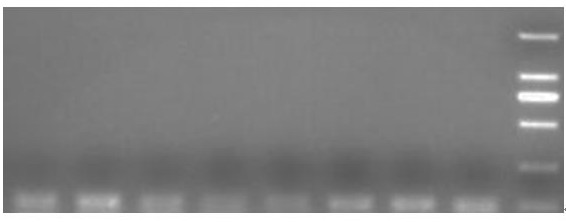Detection and identification method for acanthocephalan worm of neoechinorhynchus
An identification method and technology of acanthocephalus, applied in the direction of biochemical equipment and methods, microbial measurement/inspection, etc., can solve the problem that the species cannot be determined, the targeted protection and control work cannot be carried out smoothly, and cannot be completely effective and accurate The problem of distinguishing species and other issues can be achieved to improve the accuracy rate, the experimental results are accurate and reliable, and the accuracy rate is high.
- Summary
- Abstract
- Description
- Claims
- Application Information
AI Technical Summary
Problems solved by technology
Method used
Image
Examples
Embodiment 1
[0031] A method for detection and identification of the genus Acanthocephala, comprising the steps of:
[0032] A, according to the morphological characteristics, collect the new Acanthocephala genus Acanthocephala in the fish host;
[0033] B. Extract the DNA of the parasite sample;
[0034] C. Carry out agarose gel electrophoresis to detect the quality of the extracted DNA, if the quality is qualified, then set up a reaction system and carry out PCR amplification;
[0035] D. Sequence comparison is carried out on the sequencing results, and if the consistency is above 99%, it is determined that the species is the Acanthocephala genus Neoacantha.
Embodiment 2
[0037] This embodiment is on the basis of embodiment 1:
[0038] The collection method of the worm body sample is to scrape the contents and mucus of the digestive tract of fish, place them in a glass plate, and squeeze them with a glass plate of the same size to disperse the contents and mucus, and observe the worms with a portable dissecting microscope. body shape and collect the acanthocephala.
[0039] The size of the glass plate is 10*10 cm, which is suitable for the portable dissecting mirror used.
Embodiment 3
[0041] This embodiment is on the basis of embodiment 1:
[0042] The morphological characteristics of the genus Acanthocephala, white or light yellow, with smooth body surface without spines, banana-like in shape, slightly curved to the ventral surface, the rear part of the body is slightly thinner than the front part of the body, and the body length is about 100 inches wide. More than 3 times, females are larger than males. Elliptical giant nuclei can be seen in the body wall, with 1 on the ventral surface and 4 to 5 on the back. The snout is short and small, in the shape of an enlarged ball. The hooks are arranged in a spiral shape, 3 rows, 6 hooks in each row, 18 hooks in total; the hooks in the first row are wider, and the hooks in the second and third rows are equal in size, smaller than the hooks in the first row. There are two rod-shaped snout glands, one with 1 meganucleus and the other with 2 meganuclei; the length of snout glands varies greatly among individuals, t...
PUM
 Login to View More
Login to View More Abstract
Description
Claims
Application Information
 Login to View More
Login to View More - R&D
- Intellectual Property
- Life Sciences
- Materials
- Tech Scout
- Unparalleled Data Quality
- Higher Quality Content
- 60% Fewer Hallucinations
Browse by: Latest US Patents, China's latest patents, Technical Efficacy Thesaurus, Application Domain, Technology Topic, Popular Technical Reports.
© 2025 PatSnap. All rights reserved.Legal|Privacy policy|Modern Slavery Act Transparency Statement|Sitemap|About US| Contact US: help@patsnap.com

